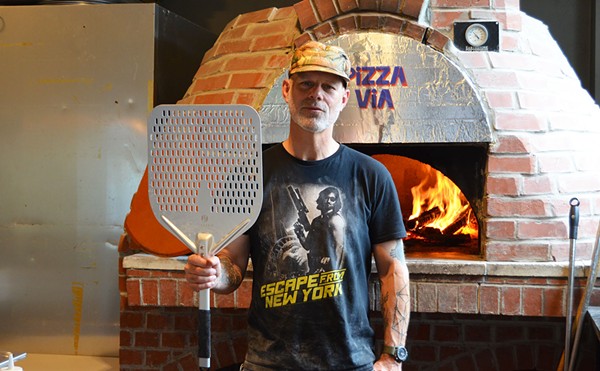Nevertheless, if ever a restaurant was in need of a neutral, starkly functional appellation, 12 North is it. The names of the owners -- Brian Hornbeck and Mark McCoy, both formerly of Café Mira -- offer no nominal possibilities except the obvious and insufferable pun on the latter's surname. And settling on a concise term to describe the restaurant's globe-trotting menu would have been difficult.
Most such catch-all menus are of the odious pizza/pasta/quesadilla genre. They are an unfortunate byproduct of the owner's determination not to lose a single customer for want of choices, right down to the Vegetarian De-Lite. The chefs at these restaurants sometimes take obscene liberties with ingredients, concocting such cultural and culinary perversions as "squid-ink cappellini with lemongrass cream" and "Biloxi bouillabaisse with sage focaccia" (these dishes are, regrettably, real examples from the menus of two now-defunct St. Louis restaurants).
Of course, nothing's wrong with borrowing unique ingredients, techniques and spices from other cultures when it makes sense to do so. 12 North's executive chef, Adam Lambay, cooks provocative dishes drawn from an array of world cuisines, namely those we would label Indian, rustic Italian, pan-Asian, French, American Southwestern and American Midwestern. His I'll-try-anything-once approach resembles that of Dave Owens, chef/owner of Cardwell's at the Plaza, whose versatility, extraordinary range and stylish plate presentations have dazzled us for years.
But Lambay is wise enough not to place the sparring flavors of these diverse cuisines in the ring together. Instead, he keeps each dish internally consistent, with perhaps a swift uppercut now and then to get our attention. He does not make the blunder of trying to turn bouillabaisse into gumbo.
On our first visit, following Lambay's culinary logic, we decided to employ a sort of Garanimals strategy to ensure the compatibility of flavors. My meal, then, paired an Indian appetizer and main course. Lambay is of partially Indian ancestry, so he has a deft hand with subtle, expressive spices. Of course, India can't be said to have a single cuisine, but Americans have become familiar with certain characteristic regional dishes and cooking techniques. Lambay's samosas are half-moons of crisp dough folded over peas and finely diced potatoes, in place of the traditional mashed-potato filling. Cilantro and mint leaves are strewn about the plate. We dipped the samosas in a chutney that was as dark as molasses and fairly pulsated with the citrusy verve of tamarind. It's doubtful that Lambay has installed a tandoor next to his Viking range, but his tandoori halibut has an authentic Mercurochrome-red tincture. The fillet is marinated in yogurt spiked with chili powder, turmeric, ginger and other spices, giving the flesh a soft, quavering texture. Lambay rounds out the plate with basmati rice stained acid-yellow with saffron. Then he stacks triangles of naan at oblique angles and spoons a raita-like cucumber-yogurt sauce over the halibut. Substituting fish for the more traditional chicken or lamb is the clever one-two punch in this dish.
My dining companion's meal had a Southwestern theme. The first course was a swank tostada goosed with Dungeness crabmeat. The corn tortilla, quartered and ranged around a simple salad of mesclun greens, was heaped with a corn salsa brightened with mint and spiced with musky cumin. The whole affair was capped with guacamole. An entrée of grilled beef tenderloin with roasted-corn polenta made a smashing entrance: A long, tapering Anaheim chile was slung like felled timber across the sturdy slab of beef. The mild chile was stuffed with a shrimp, avocado and yellow-tomato coulis before being breaded and deep-fried. This peculiar invention tasted, oddly enough, like crab Rangoon with a kick.
On another evening, we ordered the chef's tasting menu (available with 48 hours' notice). Because 12 North is a wine bar as well as a restaurant, a specially selected pour is brought with each course. All of Lambay's dishes are plated with an artistic eye, but the items on the tasting menu are particularly lovely. We began with crostini laded with Stilton, Boursin and fontina cheeses; peeled grapes; sun-dried tomatoes; and olives. This first course was accompanied by glasses of Sancerre, a wine with a knack for opening up the palate. Next came glasses of Viognier and salads of mixed greens with buttons of warm goat cheese. Spears of baby asparagus were fanned out on each plate, with tomato concassé (finely diced, seeded tomatoes) spooned across the slender stalks.
A house-made blackberry sorbet, which served as a palate cleanser before the fish course, unexpectedly became the highlight of the meal. A dark, winey scoop of it was presented on a spoon resting on an unadorned white saucer. The sorbet's jammy, vaguely minty flavor, heightened with a squeeze of lime juice, was so pure that it captured perfectly the essence of Indian summer.
The fish course was a thick medallion of opa, a Pacific species with the pale flesh and firm texture of swordfish. Lambay dressed the fish with an Asian soy-ginger glaze. A nest of soba noodles, a few pea-green edamame and a garnish of frizzled onions finished the dish, which was paired with a heavily oaked California chardonnay. The meat course, accompanied by a Spanish red wine called rioja, allowed the chef to test a new dish for his fall menu. Small-eyed lamb chops were grilled rare and displayed on a platform of smashed red potatoes. Dessert was the same delightful peach pie we'd had on our previous visit, and the wine kept coming. This time it was a late-harvest chardonnay, which is made with grapes that are allowed to ripen on the vine until they begin to shrivel, concentrating their flavors and sugars. The result is a honeyed elixir that has a raisiny fragrance layered with notes of vanilla and baked apples.
Hornbeck and McCoy have taken the unusual and shrewd step of hiring a full-time pastry chef, Carolyn Downs. As we already know, she excels at all things frigid, such as blueberry ice cream, raspberry-port ice cream and a chocolate-and-Bing-cherry semifreddo. Her desserts do not reflect a particular cuisine so much as they show off the season. Downs knocked our socks off with her redux of peach pie. First, she blind-bakes small disks of pie crust and roasts peach halves in the oven. Then she stacks the rounds double-decker fashion, alternating with layers of the roasted peaches. This "pie" is crowned with a scoop of her delightfully redundant peach ice cream, which melts over the warm fruit beneath it to create a sauce of sorts. We can't wait for Downs to have her way with apples and pumpkins this fall.
The restaurant's extraordinary service we attribute to Hornbeck's having been the general manager of Café Mira, which previously occupied the space at 12 North Meramec. During our two visits, not once did we want for anything. McCoy himself waited on our table one evening, and a waiter lured away from Tony's served the tasting menu to us. The tasks of pouring wine, replacing flatware, removing menus and so forth were carried out so deftly that we barely noticed. This activity takes place against a backdrop almost as unobtrusive. The room's soothing gray-scale tones and creamy taupes look something like a sepia photograph in which the only true color is on the plate.





